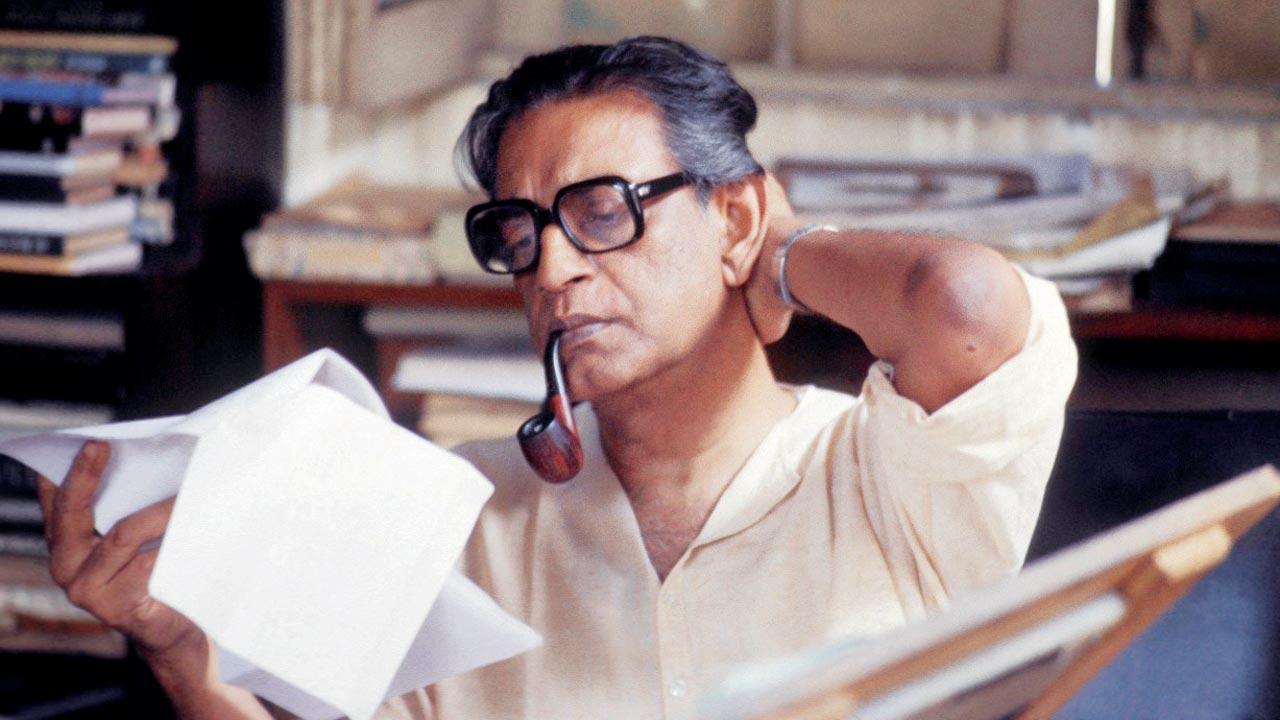Satyajit Ray garnered immense acclaim as a filmmaker, but he was also a multi-hyphenate artiste. On his birth centenary today, we visit his simultaneous careers as illustrator, science fiction writer and magazine editor, with those he worked with and inspired

A file photo of Satyajit Ray in his study at his Bishop Lefroy Road home in Kolkata. Pic/Getty Images
The whole DJ Keymer group is gone, says Sandip Ray over the phone from Kolkata, about his father’s time at the British advertising agency where he started out in 1943 as a junior visualiser. Satyajit Ray also worked as a book cover designer and illustrator with the publishing house Signet Press, established by DK Gupta, which published Jawaharlal Nehru’s Discovery of India and Bibhutibhushan Bandopadhyay’s Pather Panchali. It was while working on illustrations for an abridged version of the latter that he saw its cinematic quality and years later, in 1955, would transform his many sketches into scenes of his first film.
ADVERTISEMENT
“His main thrust in his early 20s was visuals,” says author Indrani Majumdar, who is behind the English translation of Ray’s Professor Shonku stories about the adventures of a globe-trotting scientist. In fact, Another Dozen Stories, a translation of yet another collection of Ray’s tales for younger fans, and with an introduction by Sharmila Tagore, is being released by Puffin today. “He revolutionised the whole concept of Indian design because he brought in a lot of Indian elements to suit the subject of a book,” she says.
A book cover Ray designed for a Professor Shonku story; (right) A costume sketch for his 1980 film Hirak Rajar Deshe. Pics courtesy/Sandip Ray
Speaking on translating Ray’s science fiction and adventure stories, she says it was marked by simple language full of colloquial terms, puns and literary allusions, which were often his way of paying tribute to his father Sukumar Ray, famous for his nonsense poetry. Majumdar says that this simplicity, however, does not always give in to easy translation. “That was an area of frustration for me,” she admits. Her association with Ray began when she met him to produce a calendar on Sukumar Ray when the latter’s birth centenary was celebrated in 1987. “We became pen friends after that.”
One facet of Ray’s restlessly creative career where several of his talents as a literary and graphic artist came together was in his editorship of the children’s magazine Sandesh, which his writer, illustrator and publisher grandfather Upendrakishore Ray Chowdhury founded in 1913. Ray revived Sandesh in 1961, editing it initially with poet Subhash Mukhopadhyay, and later with his aunt and famous children’s writer Leela Majumdar, and it became, as Indrani Majumdar describes “a huge platform [for him] to flourish as a writer, calligrapher, illustrator, editor and translator.”
A caricature of actress Nargis Dutt by Ray. Pic courtesy/Sandip Ray
Bengalis of different ages subscribed to the magazine and have memories of poring over its poems, short stories and delightful covers and illustrations, made often by Ray himself. His own detective, adventure and science fiction stories too, appeared in its pages, and would later be published as books.
Author Anita Agnihotri, who can still rattle off her Sandesh subscription number, recalls how one of her first poems as a five-year-old was sent to the magazine and elicited a kindly response from Mukhopadhyay and how between the ages of 12 and 18, she got her works published in the magazine. “Ray was an editor who never interfered with a child’s way of thinking. There would be no editorial corrections. Everything would go as is, and if he wanted to make a change, he would consult,” shares Agnihotri. “My continuity from a young writer to a grown-up author owes much to the way Satyajit Ray encouraged creativity without any restraint.”
The Ray Roman font he created. Pic courtesy/Sandip Ray
Ray would normally design a cover at the beginning of the Bengali new year and the same cover would run in different combinations of colours. He would also reprint some of the old covers. Artist and writer Ujjal Chakraborty, who illustrated for the magazine for 22 years, shares how Ray never engaged in heavy philosophical discussions about the art, perhaps expected from a filmmaker of his renown by then, or gave instructions about how much reality or fantasy to pour into the drawings. He says that Ray’s involvement with the magazine grew as his filmmaking career flourished and remembers him often sketching in the air in the midst of conversations, a sign of his relentlessly creative disposition. “He was a full-time writer and a part-time filmmaker,” laughs Chakraborty.
In 2018, a documentary titled Sandesh 100 was brought out with the aim of archiving the magazine. Its director Soumyakanti Dutta, who grew up with issues of the magazine in his house, was also inspired by the project to start publishing his own magazine Bichitra Patra, with Sandip Ray as advisor, to print some of Ray’s unpublished writings.
 Subscribe today by clicking the link and stay updated with the latest news!" Click here!
Subscribe today by clicking the link and stay updated with the latest news!" Click here!






